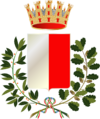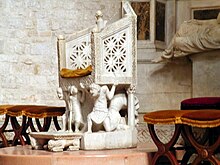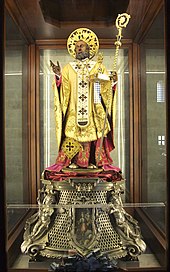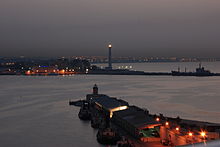Bari
| Bari | ||
|---|---|---|

|
|
|
| Country | Italy | |
| region | Apulia | |
| Metropolitan city | Bari (BA) | |
| Coordinates | 41 ° 8 ' N , 16 ° 52' E | |
| height | 5 m slm | |
| surface | 116 km² | |
| Residents | 322,316 (Dec. 31, 2019) | |
| Post Code | 70100 (generico), 70012, 70016, 70045, 70050, 70057, from 70121 to 70126 | |
| prefix | 080 | |
| ISTAT number | 072006 | |
| Popular name | Baresi | |
| Patron saint | Nikolaus von Myra (May 9th), Sabino von Canosa , Madonna Hodegetria | |
| Website | www.comune.bari.it | |
 Clockwise from above: Castello Normanno-svevo, Gulf of Bari, Piazza Umberto I, Lungomare and Piazza del Ferrarese |
||
Bari is an Italian municipality , capital of the Apulia region and the center of the metropolitan city of Bari and an important port and university city on the Adriatic Sea .
Geographical location
Bari has 322,316 inhabitants (as of December 31, 2019), the metropolitan city of the same name with 3,825 km² about 1.3 million inhabitants.
The neighboring municipalities are Adelfia , Bitonto , Bitritto , Capurso , Giovinazzo , Modugno , Mola di Bari , Noicattaro , Triggiano and Valenzano .
climate
| Bari | ||||||||||||||||||||||||||||||||||||||||||||||||
|---|---|---|---|---|---|---|---|---|---|---|---|---|---|---|---|---|---|---|---|---|---|---|---|---|---|---|---|---|---|---|---|---|---|---|---|---|---|---|---|---|---|---|---|---|---|---|---|---|
| Climate diagram | ||||||||||||||||||||||||||||||||||||||||||||||||
| ||||||||||||||||||||||||||||||||||||||||||||||||
|
Average monthly temperatures and rainfall for Bari
Source:
|
|||||||||||||||||||||||||||||||||||||||||||||||||||||||||||||||||||||||||||||||||||||||||||||||||||||||||
history
Bari was already inhabited during the Middle Bronze Age. Traces of settlement from the Middle Bronze Age (approx. 1700–1350 BC) to the Early Iron Age (from approx. 950 BC) were found in several places in today's old town: around the churches of St. Peter, S. Scolastica and S. Maria del Buonconsiglio. The finds also include fragments of Mycenaean clay vessels from the late Helladic III B and III C (late 14th to 12th / 11th centuries BC), which indicate trade with Greece. Later Bari was a town of the Peuketeers in Apulia. Greeks settled in the city they called Barion . As part of the Roman Empire , it was given the name barium . As early as 180 BC BC it appears as an important port, had strong fishing and owned since 89 BC. The status of a municipality . During this time the city was able to enact its own laws and mint its own coins. She lay on the of Sipontum (now Siponto ) to Brundisium (now Brindisi leading) coastal road and at the after Benevento running Via Traiana . Another road led from Bari to Taranto . Since the 4th century the place has been the seat of a diocese, today's Archdiocese of Bari-Bitonto . After the fall of the Western Roman Empire (476), Bari came first to the Goths , then to the Byzantine Empire .
In 690 Romuald of Benevento wrested the city from the Byzantines, who regained Bari in 720. In 755 it was taken from Pippin the Younger , and in 802 it fell to the Duke of Benevento. In 847 a Saracen fleet conquered the city and founded an Islamic emirate in Italy there. In 871 Bari was again taken by the Byzantine Empire, which established the center of its Italian territories there. The Byzantines successfully defended the city against further attacks by the Saracens in 988 and 998. Although Bari was conquered again by Arabs in 1002, it was quickly recaptured by the Byzantine army . The Barens Melus (Melo) rose against the Byzantines in 1009 and 1017; as Ismahel (Ismail) he is immortalized on the gold embroidered star cloak that he had given to the German Emperor Heinrich II .
On April 15, 1071, after three years of siege, the Normans under Robert Guiskard conquered the city, which at that time was the last possession of Byzantium in Italy. In 1087 the bones of St. Nicholas were brought to Bari from Myra . The saint has since been known in Italy as Nicola di Bari. In 1096 a large part of the crusader army embarked in the port of Bari for the First Crusade . In October 1098, Pope Urban II called the "Council of Bari" , at which Anselm of Canterbury was present and at which no solution for the reconciliation of the Roman Catholic Church with the Orthodox Churches could be reached. In 1155 the inhabitants of the city rebelled against the Normans and negotiated with the Byzantines. As a retaliatory action, Wilhelm I "the bad one" had the city destroyed except for the cathedral and the Basilica of St. Nicola in June of the following year and drove the residents away. It was not until 1166 that Wilhelm II approved the reconstruction. After the death of Henry VI. In 1197 Bari came under papal rule for some time.
Bari experienced a heyday under Frederick II . This first came to the city in 1221. When he returned from his crusade after 1229, the city gates were locked so he had to use force to gain entry. Therefore, he probably had the fort built in 1233 to keep the city in check. On the other hand, he granted the city generous trade privileges and left it the leading role in the region. In 1239 he began a great port construction near San Cataldo, which was discontinued the following year.
Bari was hard hit by the preference of foreign merchants and bankers among the Anjou . Robert of Anjou gave Bari as a principality to his favorite Amelio del Balzo. In the 15th century it came to the Sforza as a duchy and in 1558 was incorporated into the Spanish viceroyalty of Naples. In 1730 an earthquake shook the city. After numerous turmoil and power struggles among the nobility , the construction of the new town only began in 1813 under Joachim Murat , Napoleon's brother-in-law who had risen to become King of Naples . In 1860 Bari came to the newly founded Kingdom of Italy .
- In 1865 the first railway line from Bari to Brindisi was inaugurated.
- In 1905, much of the city was flooded.
- The university was opened in 1925.
- In 1926 Bari was hit again by a flood.
- On December 2, 1943, during a German air raid on the port of Bari with 105 Junkers Ju 88 bombers, 28 Allied ships were destroyed, 12 others were damaged and around a thousand people were killed. The 2,000 AN-M47 - mustard gas bombs loaded US liberty ship SS John Harvey exploded, causing 628 soldiers were injured, of whom died 83rd
- After the end of the Second World War , the American military administration set up a DP camp for Jewish displaced persons near the port . The DP camp, which temporarily housed up to 1,700 refugees, served mainly as a transit camp for emigrants to Israel .
- In 1991, thousands of refugees from Albania came to Apulia in several waves on overloaded ships. With the Vlora alone , over 10,000 Albanians reached Bari on August 8th. They were taken to the old football stadium Stadio della Vittoria , where they stayed in precarious conditions until they were repatriated.
Tourist Attractions
Museo Archeologico Nazionale
The museum with important Greek and Roman excavation objects from all over Puglia was located on the first floor of the university until 1994. Then it was closed for security reasons. At the end of 2015, the redesigned museum in the Santa Scolastica monastery was opened, but for the time being only parts of the old structure can be seen there; the exhibits are still under lock and key.
Basilica of San Nicola
“Almost all of the most entrepreneurially active seaside towns had their highly respected saints: Venice its Markus (evangelist), Naples its Januarius (early Christian martyr), Salerno its Matthew (apostle and evangelist) and the oldest maritime republic of Amalfi its Andreas (apostle). Genoa, as one of the last of the great Italian sea cities, secured the bones of John the Baptist on the occasion of the first crusade. ” In 1087, Bari was relatively late in acquiring a high relic. His grave was in Myra , the place where Saint Nicholas worked . The southern Italian seafarers broke open the sarcophagus in 1087 and brought the remains to their hometown of Bari. One justified and excused the robbery with the fact that the relic should be secured before the conquest of Myra by the Seljuks . The Turkish Seljuks had inflicted a defeat on the Byzantines at the Battle of Manzikert in 1071 , after which the inhabitants of Myra fled to the mountains. For the precious relic, the Basilica of San Nicola was built on the ruins of the former residence of the Byzantine governor. The implementation was entrusted to Elias, the abbot of the nearby Benedictine monastery, who became Bishop of Bari in 1089. The final consecration took place in 1196 (other sources say that the church was consecrated by Pope Urban II in 1098 ).
S. Nicola is the founding building of the Bares Romanesque . The oldest component is the east choir , the apses of which , just like in Bitonto , were encased in the 12th century and structured with blind arcades . The pilgrimage church of San Nicola is north of the cathedral . The basilica was originally very close to the water like the Cathedral of Trani . Only a sea wall separated them from the sea. It is surrounded by three large courtyards, around which the remaining buildings of the monastery are grouped, in the south the monastery, in the west the hospice and pilgrims' home and in the north-west the church of S. Gregorio.
S. Nicola introduced this special outer structure of the nave with the high niches and the galleries above . The archaic -looking facade of the church is determined by separately highlighted cubic components. The two lateral tower stumps go back to Norman models in northern France, Caen , Jumièges and so on. The towers are reminiscent of S. Abbondio in Como , the dwarf galleries and the blind arcades on the exterior as well as the galleries inside the church are primarily reminiscent of Modena Cathedral . Relations with Northern Italy are generally close, although the temporal genesis, i.e. the mutual dependency, is still largely unclear.
The entrance portal is the only one in Puglia to have bulls as pillars instead of the usual lions.
The interior no longer has the original shape. For reasons of statics, the western columns were doubled in the 15th century and connected by arches, creating candle arches that now define the interior and greatly impair the spatial effect.
The bones of St. Nicholas are kept in the crypt . The Church is entrusted to the Dominicans ; In the crypt there are possibilities for a Catholic and an Orthodox service: the main altar above the reliquary grave and the left side altar with an iconostasis . The tomb of St. Nicholas is highly venerated in Orthodoxy and there is a great pilgrimage .
Festa di San Nicola
Every year, Bari celebrates a great festival in honor of St. Nicholas from May 7th to 9th, the presumed day of the arrival of their ships after the stolen bones. The streets and squares are decorated. The statue of Saint Nicholas, accompanied by over 400 people in historical costumes, is carried in procession from the basilica to the port. You can then use it to go around the bay on a boat.
San Sabino Cathedral
The cathedral was built between 1170 and 1178. It is a three-aisled pseudo-gallery basilica with a large east transept , to which the apses are directly connected. The gallery openings of the nave simulate gallery lying in the side aisles , which do not exist. The side aisles are almost as high as the central nave, which only has an extremely flat upper aisle for exposure.
Inside, in addition to the pulpit and the rich ornamentation of the cathedral, the reconstructed altar area with the ciborium composed of original parts and the bishop's throne are noteworthy. In the baroque over-molded crypt there are some medieval frescoes.
The Episcopal See of Elias

The most important work of art inside the Basilica San Nicola is the cathedra , the bishop's seat of Elias from around 1098. A bishop's seat usually had a higher seat than other chairs in the church. Splendid cathedrals of this type are part of a long chain of tradition that can be traced back to the 6th century using examples in the Adriatic region.
What distinguishes the throne in Bari from its predecessor in Ravenna and from others is the figural design of the base. The entire load-bearing structure is a sculptural act of acting people, who can clearly see the load they are carrying. The different proportions of the respective workload are sensitively differentiated. The two main girders on the left and right are obviously groaning under the load, while the smaller figure in the middle is only leaning loosely by hand.
“Your attribute, the pilgrim's staff , shows your real task: the pilgrimage. [...] Here in S. Nicola only the pilgrim to St. Nicholas, and he is ultimately an essential 'bearer' of the new meaning of Bari in general and of the Abbot of S. Nicola in particular. The back of the throne substructure is finally marked as architecture by three short octagonal columns. Here, too, the action predominates, because between the little pillars, unequally heavier, two large lionesses are fully concentrated on snatching some pitiful figure between their clutches. Lions, generally understood in the Middle Ages as a symbol of the animal and evil, but also as a symbol for Christ, probably have an apotropaic (disaster-averting) function here when placed on the back. The throne is equipped with a flat marble stool that balances the height of the pedestal, also above lying lions "
An archetype of this form made of carved ivory tablets is in Ravenna, the so-called Maximian cathedra from the middle of the 6th century. The tradition of stone rulers' seats reached north of the Alps via Ravenna, for example to Aachen, where thrones made of wood or metal were obviously in use until then.
Fort

The construction of the Castello Normanno-Svevo di Bari (Eng .: Norman-Staufer castle) was started in 1131–1132 on the orders of Roger "the Normans" . The castle stands on the remains of a Byzantine fortress from the 11th century. During excavations, constructions were uncovered in the north and west wings, which certainly indicate that a sacred building existed before the Byzantine development, which belongs to the oldest city center of Bari.
In 1139 the fort was rebuilt after being destroyed. The castle was again badly damaged by the uprising against the Normans in 1155.
During the Staufer period , the fort was rebuilt from 1233 under Emperor Friedrich II . Building on the existing Norman floor plan, two polygon towers were built, and for the first time the fort was reinforced by external fortifications, as recent studies on the eastern side of the bastion have shown. A 45 meter long barrel vault with square columns was excavated within the fortifications at the level of the inner courtyard . A moat was created. The hallmarks of the Staufer era are the pillars and arches, richly decorated with figures, for which outstanding Muslim stonemasons were recruited.
Since the arrival of Isabella of Aragón , the castle has been converted into a palace, the high point reached the court life under Isabella's daughter Bona Sforza , who used Bari as a widow's residence after the death of her husband Sigismund I. The inner courtyard was rebuilt in the Renaissance style, a chapel was built and dedicated to St. Stanislaus .
After the death of Bona Sforza, the castle was temporarily abandoned and was later converted into a prison. Today there is a museum in which changing exhibitions are shown. On May 7, 2009, a Staufer stele was inaugurated in the green area of the Giardini Isabella d'Aragona on the west side of the fort .
Piccinni Theater
In honor of the Bari-born composer Niccolò Piccinni , this theater was named in 1855. It was opened in 1854 . It is the oldest preserved theater building in the city.
economy
There are essentially three major branches of industry in Bari: chemical industry, metal industry and automotive industry (suppliers). This also explains the branches of important German companies in Bari, such as Bosch , Osram or GETRAG . The port also plays an important role as a service provider.
traffic
Shipping
The port of Bari is one of the major Italian ferry ports on the Adriatic with regular connections for vehicles and passengers to Dubrovnik , Bar , Durrës , Patras and Corfu , Igoumenitsa , Kefalonia and Zakynthos . In 2012, two million passengers were counted, of which 650,000 were cruise ship passengers . In 2011, around five million tons of goods were turned over in the freight port and trading port. Three marinas offer berths for pleasure boats. The port, at which a coordination point for sea rescue is based, has five port basins and is exposed to the northeast. In the south is the old picturesque fishing port. The port of Brindisi is 60 nautical miles south and the port of Ancona is 210 nautical miles north .
railroad
The main train station Bari Centrale is located on the Adriatic railway (km 648.6 counted from Bologna Centrale ). It is the starting point of the Bari – Taranto railway line . Both belong to the Rete Ferroviaria Italiana of the Ferrovie dello Stato Italiane (FS). In addition, Bari Centrale is the starting point for three private railways :
- Railway line Bari – Martina Franca – Taranto of Ferrovie del Sud Est (to be incorporated into the FS soon)
- Bari – Barletta railway operated by Ferrotramviaria SpA
- narrow-gauge railway line Bari – Matera (950 mm) of the Ferrovie Appulo – Lucane
Air travel
The Bari airport (Italian Aeroporto di Bari-Palese "Karol Wojtyla" ) is located eight kilometers north-west of Bari and is mainly of low cost airlines controlled.
education
The University of Bari has approximately 70,000 students one of the largest in Italy.
Sports
The football club SSC Bari has played 28 seasons in the top division of Italian football, Serie A, and is in the third division, Serie C , for the 2019/20 season . The club's venue is the Stadio San Nicola , which can seat 58,270 spectators .
From 1947 to 1956, the Gran Premio di Bari automobile race took place on the promenade in Bari .
Personalities
Famous personalities of the city are included in the list of personalities of the city of Bari .
Town twinning
-
 Guangzhou , China , since 1986
Guangzhou , China , since 1986 -
 Batumi , Georgia , since 1987
Batumi , Georgia , since 1987 -
 Mar del Plata , Argentina , since 2001
Mar del Plata , Argentina , since 2001 -
 Corfu , Greece , since 2006
Corfu , Greece , since 2006 -
 Banja Luka , Bosnia and Herzegovina , since 2007
Banja Luka , Bosnia and Herzegovina , since 2007 -
 Durrës , Albania
Durrës , Albania
-
 Patras , Greece
Patras , Greece
-
 San Nicolás de Bari ( La Habana ), Cuba , since 2007
San Nicolás de Bari ( La Habana ), Cuba , since 2007 -
 Vladimir , Russia , since 2013
Vladimir , Russia , since 2013 -
 ( ) Sukhum , Abkhazia , since 2017
( ) Sukhum , Abkhazia , since 2017
Climate table
|
Average monthly temperatures and rainfall for Bari
Source: WMO ; Humidity, duration of sunshine, water temperature: wetterkontor.de
|
|||||||||||||||||||||||||||||||||||||||||||||||||||||||||||||||||||||||||||||||||||||||||||||||||||||||||||||||||||||||||||||||||||||||||||||||||||||||||||||||||||||||||||||||||||||||||||||||||||
See also
literature
- Gerardo Cioffari: Storia della chiesa di Bari. Dalle origini alla fine del dominio bizantino (1071) . Centro Studi Nicolaiani, Bari 1992.
- Ekkehart Rotter: Apulia . Trips to Byzantine grotto churches, Norman cathedrals, Staufer forts and baroque buildings in Lecce. (= DuMont art travel guide ). 6th edition. Dumont Reise Verlag, Ostfildern 2012, ISBN 3-7701-4314-0 .
Web links
- Website of the city of Bari (Italian)
Individual evidence
- ↑ Statistiche demografiche ISTAT. Monthly population statistics of the Istituto Nazionale di Statistica , as of December 31 of 2019.
- ^ World Weather Information Service. Retrieved July 16, 2019 .
- ^ Marco Bettelli: Italia meridionale e mondo miceneo. Ricerche su dinamiche di acculturazione e aspetti archeologici, con particolare riferimento ai versanti adriatico e ionico della penisola italiana . Florence 2002, p. 22f.
- ↑ Titus Livius , Ab urbe condita 40, 18; Strabo . Geographika 5, 283.
- ^ Tacitus , Annals 16, 9.
- ^ Christian Hülsen : Barium . In: Paulys Realencyclopadie der classical antiquity science (RE). Volume III, 1, Stuttgart 1897, Col. 19.
- ↑ David Abulafia: The Mediterranean: A Biography. Fischer, Frankfurt 2014, ISBN 978-3-596-17441-6 , p. 335.
- ^ Rolf Legler: Apulia . 3. Edition. Cologne 1989, p. 119.
- ^ Marcel Durliat: Romanesque Art . Freiburg im Breisgau 1983, p. 579.
- ^ Rolf Legler: Apulia . 3. Edition. Cologne 1989, p. 133.
- ↑ Bari 2009 on stauferstelen.net. Retrieved March 23, 2014.
- ^ Railway Atlas Italy and Slovenia / Atlante ferroviario d'Italia e Slovenia . Schweers + Wall 2010. ISBN 978-3-89494-129-1 , p. 81.
- ↑ Vladimir: Sister Cities
- ↑ Mayor of Sukhum signed a protocol of intentions with one of the Italian cities , mfaapsny.org April 28, 2017.














